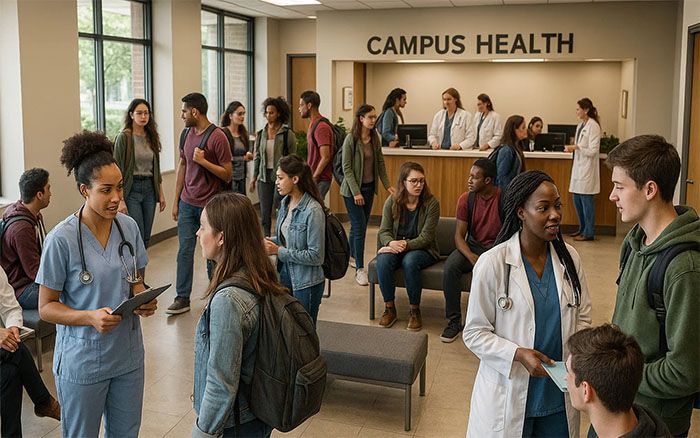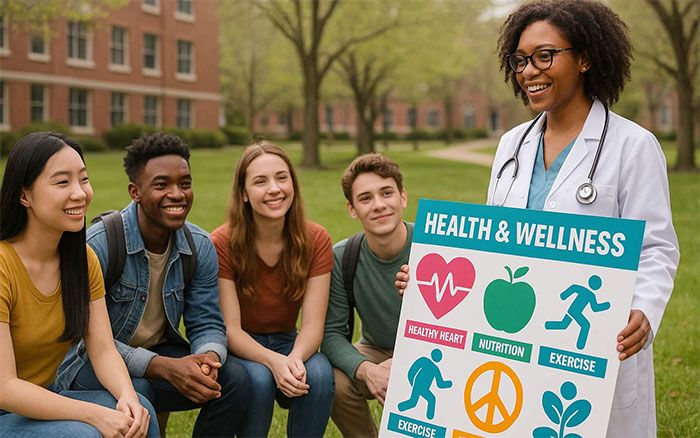Health Promotion Through Social Media:
Effective Strategies and Best Practices
Social media has become an indispensable tool for promoting health initiatives, especially among Gen Z students. This demographic, born between 1997 and 2012, is the first truly digital native generation, making them a crucial audience for college health campaigns.
Understanding how to effectively leverage social media to connect with Gen Z can significantly enhance your health promotion efforts on campus. Here are some tips, trends, and best practices for colleges to consider.
1. Promote on the Right Platforms
According to Morning Consult’s report, YouTube is the most-used platform for Gen Z, with over 80% spending time on the app. Instagram follows closely in the second spot at 75%, indicating that the platform remains highly popular. TikTok (69%) and Snapchat (63%) are also significant players, demonstrating their continued relevance among Gen Z users.
This stresses the importance of ensuring that your college is utilizing these platforms for health promotion to reach the greatest number of students.

2. Leverage Influencer Partnerships
Leverage influencer partnerships by collaborating with student influencers or popular figures on campus who resonate with Gen Z. These individuals can provide credible and relatable voices for sharing health messages. Micro-influencers, with their smaller but highly engaged followings, can be especially effective in fostering a sense of community.
Colleges can effectively advertise health promotion initiatives by leveraging YouTube’s extensive reach among Gen Z, creating engaging video content that resonates with students. Additionally, maintaining an active presence on Instagram, TikTok, and Snapchat with creative and authentic posts will ensure that health messages are seen and embraced by this tech-savvy generation.
3. Utilize User-Generated Content
User-generated content (UGC) is defined as “consumer-generated content.” You can incorporate this on your campus by encouraging students to create content themselves, such as photos, videos, and stories about their experience utilizing health services on your campus.
Schools may also consider launching campaigns with specific hashtags, hosting contests, and highlighting student contributions on their official social media platforms, fostering a sense of community and engagement. (P.S. – this could be great for marketing majors to take part in).
4. Focus on Authenticity and Transparency
According to Forbes, Gen Z highly values authenticity and transparency. Share real stories, and behind-the-scenes content, and be transparent about your mission and values. Avoid overly polished or corporate-sounding messages.
5. Provide Value with Educational Content
Provide value with educational content by sharing tips, tutorials, and educational posts that offer real benefits to your audience. Use features like Instagram Stories’ “Swipe Up” or link stickers to direct followers to additional resources.
For example, one idea could be to create a series called, “Wellness Wednesdays,” where each week, your clinic shares valuable health tips and tutorials on topics like stress management, healthy eating, exercise routines, and mental health awareness.
For example, an Instagram Story might include a short tutorial on how to do a particular mindfulness meditation technique, followed by a swipe-up link directing followers to a detailed blog post or video on the college’s health center website on the topic.
A video on YouTube could showcase a nutritious, budget-friendly recipe with step-by-step instructions and a link directing students to a downloadable meal plan. Access to information about the Basic Needs Hub for students struggling with food insecurity could be included in the video’s caption section.
6. Engage in Real-Time Interactions
Engage in real-time interactions by utilizing live streaming features on Instagram, TikTok, and YouTube to host health and wellness Q&A sessions, webinars, or live discussions. You may find that more students attend virtually than you would think. Respond promptly to comments and messages to foster a sense of connection and community.
Additionally, colleges can record these live sessions and upload them to their YouTube channel, blog, or website as “evergreen content.”
7. Promote Mental Health Awareness
Gen Z is more open to discussing and addressing mental health than other generations. For instance, less than 3 percent of individuals aged 65 and older have received treatment directly from mental health professionals, whereas over a third of Gen Zers have reported receiving medical treatment or therapy from such professionals.
Continue to promote mental health awareness in new and fun ways by focusing on the wide variety of wellness-related support available on campus. Share content that normalizes seeking help and provides practical mental health tips that students can easily implement in their daily (and busy) lives.
8. Use Data-Driven Insights
Finally, to improve the content you share over time, track key social media metrics like your follower count, impressions, interactions, shares, and comments to understand what content resonates most with your audience. Adjust your strategy based on these insights to continually improve your reach across campus.
Best Practices for Connecting with Gen Z
-
Stay Current with Trends
To effectively connect with Gen Z, stay current with the latest social media trends and platform updates. Gen Z quickly adopts new features and trends, so staying updated can help keep your content relevant!
-
Encourage Interaction
Encourage interaction by using polls, quizzes, and interactive posts to engage your audience. Interactive content not only boosts engagement but also provides insights into your audience’s preferences and opinions.
-
Focus on Diversity and Inclusion
Highlight diversity and inclusion by ensuring that your content reflects a wide variety of voices, perspectives, and stories across your campus community. This creates an inclusive environment and resonates with Gen Z’s values.
-
Be Consistent
Be consistent by maintaining a regular posting schedule to keep your audience engaged. Consistency helps build trust, “feeds the algorithm,” and keeps your content top of mind.
Key Takeaways
Promoting health initiatives through social media is an evolving and dynamic process, especially when targeting the digitally savvy Gen Z.
By understanding their preferences and behaviors, and implementing these best practices, colleges can create impactful and engaging physical and mental health promotion campaigns.

















